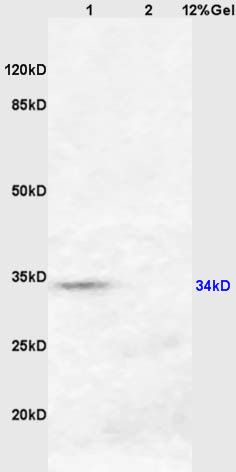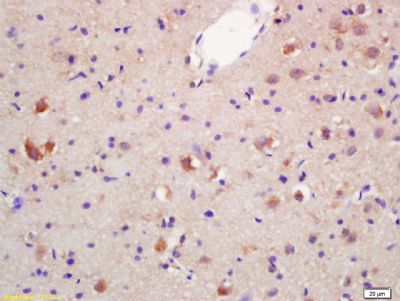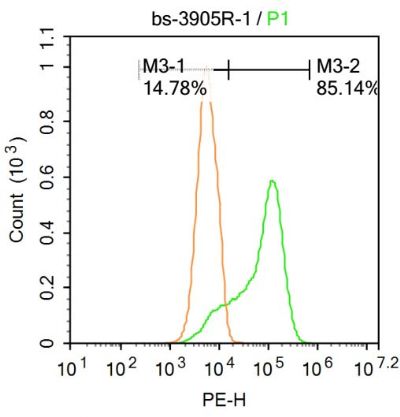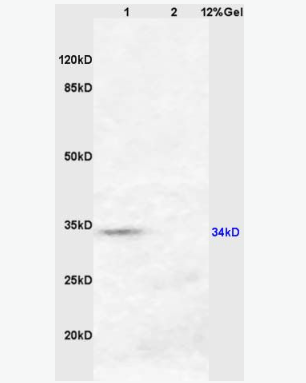| 中文名稱 | 羥類固醇脫氫酶17β3抗體 |
| 別 名 | 17 beta HSD 3; 17-beta-hydroxysteroid dehydrogenase type 3; EDH17B3; Estradiol 17 beta dehydrogenase; Estradiol 17 beta dehydrogenase 3; Hydroxysteroid (17 beta) dehydrogenase 3; Testicular 17 beta hydroxysteroid dehydrogenase; Testosterone 17 beta dehydrogenase 3; DHB3_HUMAN. |
| 研究領域 | 腫瘤 細胞生物 免疫學 發(fā)育生物學 轉錄調(diào)節(jié)因子 激酶和磷酸酶 |
| 抗體來源 | Rabbit |
| 克隆類型 | Polyclonal |
| 交叉反應 | Human, Mouse, Rat, (predicted: Pig, Cow, Horse, Rabbit, ) |
| 產(chǎn)品應用 | WB=1:500-2000 ELISA=1:500-1000 IHC-P=1:100-500 IHC-F=1:100-500 Flow-Cyt=1ug/test IF=1:100-500 (石蠟切片需做抗原修復) not yet tested in other applications. optimal dilutions/concentrations should be determined by the end user. |
| 分 子 量 | 34kDa |
| 細胞定位 | 細胞漿 |
| 性 狀 | Liquid |
| 濃 度 | 1mg/ml |
| 免 疫 原 | KLH conjugated synthetic peptide derived from human HSD17B3:101-200/310 |
| 亞 型 | IgG |
| 純化方法 | affinity purified by Protein A |
| 儲 存 液 | 0.01M TBS(pH7.4) with 1% BSA, 0.03% Proclin300 and 50% Glycerol. |
| 保存條件 | Shipped at 4℃. Store at -20 °C for one year. Avoid repeated freeze/thaw cycles. |
| PubMed | PubMed |
| 產(chǎn)品介紹 | HSD17B3 is involved in the reduction of androstenedione to testosterone. It is expressed predominantly in the testis. Deficiency in HSD17B3 are the cause of male pseudohermaphrodism with gynecomastia (MPH). Function: Favors the reduction of androstenedione to testosterone. Uses NADPH while the two other EDH17B enzymes use NADH. Tissue Specificity: Testis. DISEASE: Defects in HSD17B3 are the cause of male pseudohermaphrodism with gynecomastia (MPH) [MIM:264300]. These individuals have unambiguous female external genitalia at birth, but fail to menstruate at the time of expected puberty and instead virilize as evidenced by growth of the phallus. Breast development may or may not take place. Similarity: Belongs to the short-chain dehydrogenases/reductases (SDR) family. 17-beta-HSD 3 subfamily. SWISS: P37058 Gene ID: 3293 Database links: Entrez Gene: 3293 Human Omim: 605573 Human SwissProt: P37058 Human Unigene: 477 Human Important Note: This product as supplied is intended for research use only, not for use in human, therapeutic or diagnostic applications. |
| 產(chǎn)品圖片 |  Sample: Sample:Brain (Mouse) Lysate at 40 ug Testis (Mouse) Lysate at 40 ug Primary: Anti-HSD17B3 (bs-3905R) at 1/300 dilution Secondary: HRP conjugated Goat-Anti-rabbit IgG (bs-0295G-HRP) at 1/5000 dilution Predicted band size: 34 kD Observed band size: 34 kD  Tissue/cell: rat brain tissue; 4% Paraformaldehyde-fixed and paraffin-embedded; Tissue/cell: rat brain tissue; 4% Paraformaldehyde-fixed and paraffin-embedded;Antigen retrieval: citrate buffer ( 0.01M, pH 6.0 ), Boiling bathing for 15min; Block endogenous peroxidase by 3% Hydrogen peroxide for 30min; Blocking buffer (normal goat serum,C-0005) at 37℃ for 20 min; Incubation: Anti-HSD17B3 Polyclonal Antibody, Unconjugated(bs-3905R) 1:200, overnight at 4°C, followed by conjugation to the secondary antibody(SP-0023) and DAB(C-0010) staining  Paraformaldehyde-fixed, paraffin embedded (Mouse testis); Antigen retrieval by boiling in sodium citrate buffer (pH6.0) for 15min; Block endogenous peroxidase by 3% hydrogen peroxide for 20 minutes; Blocking buffer (normal goat serum) at 37°C for 30min; Antibody incubation with (HSD17B3) Polyclonal Antibody, Unconjugated (bs-3905R) at 1:400 overnight at 4°C, followed by operating according to SP Kit(Rabbit) (sp-0023) instructionsand DAB staining. Paraformaldehyde-fixed, paraffin embedded (Mouse testis); Antigen retrieval by boiling in sodium citrate buffer (pH6.0) for 15min; Block endogenous peroxidase by 3% hydrogen peroxide for 20 minutes; Blocking buffer (normal goat serum) at 37°C for 30min; Antibody incubation with (HSD17B3) Polyclonal Antibody, Unconjugated (bs-3905R) at 1:400 overnight at 4°C, followed by operating according to SP Kit(Rabbit) (sp-0023) instructionsand DAB staining. Blank control: Raji. Blank control: Raji.Primary Antibody (green line): Rabbit Anti-HSD17B3 antibody (bs-3905R) Dilution: 1μg /10^6 cells; Isotype Control Antibody (orange line): Rabbit IgG . Secondary Antibody : Goat anti-rabbit IgG-PE Dilution: 1μg /test. Protocol The cells were fixed with 4% PFA (10min at room temperature)and then permeabilized with PBST for 20 min at room temperature. The cells were then incubated in 5%BSA to block non-specific protein-protein interactions for 30 min at at room temperature .Cells stained with Primary Antibody for 30 min at room temperature. The secondary antibody used for 40 min at room temperature. Acquisition of 20,000 events was performed. |
我要詢價
*聯(lián)系方式:
(可以是QQ、MSN、電子郵箱、電話等,您的聯(lián)系方式不會被公開)
*內(nèi)容:









